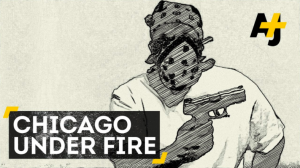Exposure to gun violence is a prevalent problem in Chicago and has drastic effects on adolescents in all areas of their lives. As a well researched topic among scholars, studies suggest that violence exposure has a negative impact on youth’s education and encourages delinquent behavior. Here, the works of Julia Burdick-Will and Kathan Shukla and Margit Wiesner are explored. Both articles discuss the effects of violence exposure on adolescents – academically and socially.
The Problem: Violence Exposure Negatively Impacts Students
Shukla and Wiesner (2016) state that “exposure to violence remains a pervasive public health problem for adolescents in the United States” (p. 423). In a national survey by the U.S. Department of Justice administered in 2009, results revealed that “60% of the children and adolescents surveyed were exposed to violence within the past year” (Finkelhor et. al., as cited in Shukla and Wiesner, 2016). With such high levels of exposure to violence during adolescence in the United States, the effects of this public health problem are of great concern.
In Brudick-Will’s study, she discusses the large body of research that points to the importance of early experiences as they pertain to a child’s academic, economic, and social successes later in life. Growing up in a violent neighborhood has detrimental effects on a child’s life and can have “cascading influence” and lead to “long-term effects on students’ engagement in the schooling process” (Burdick-Will, 2016, p. 134). Early exposure to violence “shapes students’ behavior, engagement, and educational trajectories that build over time” (Burdick-Will, 2016, p. 134), meaning students who live in violent neighborhoods end up far behind students living with better circumstances.
The Effects: Behaviorally, Emotionally, Academically
Adolescents who encounter victimization or witness violence experience negative effects like a “greater risk of running away from home, dropping out of high school, having a child, attempting suicide, and coming into contact with the criminal justice system” (Shukla and Wiesner, 2016, p. 424). Shukla and Wiesner further discuss being subject to violence in school negatively affects students’ ability to receive a quality education. Emotional and social distractions caused by exposure to violence work against motivations to stay in school.
Burdick-Will (2016) found that the “test scores of students who live in violent neighborhoods as young children grow more slowly over time” (p. 152). This means that students exposed to violence achieve less in school. Additionally, exposure to violence at a young age can cause “chronic psychological stress” and “protective behavior [that may be] at the expense of academic engagement” (Burdick-Will, 2016, p. 137). Such behavior is categorized as anti-academic; the effects of violence on children’s possible academic achievement is negative.
Possible Solutions
Important to note from Burdick-Will’s (2016) study is the fact “neighborhoods shape life chances” (p. 152). The effects of neighborhood violence are “long lasting [and] accumulate over time” (Burdick-Will, 2016, p. 153), so if violence were to reduce, student achievement would consequently increase. Improving safety in violent neighborhoods would “not only improve the quality of life…, but may have long-term benefits for the overall public school system as well” (Burdick-Will, 2016, p. 154).
Further, Shukla and Wiesner (2016) suggest that “school districts and other relevant institutions should increase awareness about the importance of a safe home environment, …especially those residing in economically disadvantaged areas with high proportions of ethnic majority groups” (p. 439). Such neighborhoods are often the sites of high violence rates and a more localized focus on combating the pervasive violence could help eventually reduce it.

